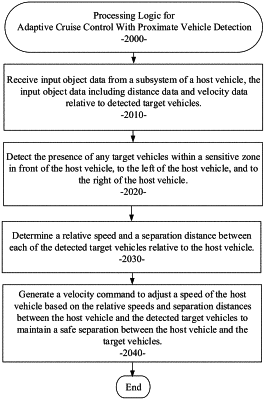| CPC B60W 30/16 (2013.01) [B60W 30/143 (2013.01); B60W 2420/52 (2013.01); B60W 2520/10 (2013.01); B60W 2554/801 (2020.02); B60W 2554/804 (2020.02); B60W 2720/10 (2013.01); B60W 2754/30 (2020.02)] | 20 Claims |

|
1. A system comprising:
a data processor; and
an adaptive cruise control module, executable by the data processor, being configured to:
receive input object data from a subsystem of a host vehicle, the input object data including distance data and velocity data relative to detected target vehicles, wherein the input object data comprises camera image data processed by an image data processor to detect objects proximate to the host vehicle;
detect the presence of a plurality of objects within a plurality of sensitive zones proximate to the host vehicle based on the input object data;
identify a plurality of proximate target vehicles from the plurality of detected objects using analysis of the camera image data;
obtain ancillary data via an in-vehicle control system of the host vehicle, the ancillary data specifying a current context of the host vehicle, the context including a specified destination of the host vehicle, a time of day, a direction of travel, speed, and a current operational status of the host vehicle;
configure operation of the adaptive cruise control module based on the ancillary data;
determine a weighted relative speed and a weighted separation distance between each detected target vehicle of the plurality of proximate target vehicles relative to the host vehicle; and
generate a velocity command to adjust a speed of the host vehicle based on the weighted relative speed and weighted separation distance between the host vehicle and each of the detected target vehicles to maintain a separation between the host vehicle and each of the detected target vehicles, wherein the velocity command is further based on a speed of each of the detected target vehicles.
|